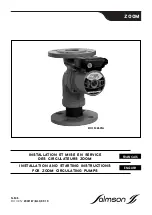
3. If the pump is inoperative for a long period of time, or appears
not to use any grease, remove and clean the cup thoroughly.
Caked grease in the cup can create a problem of
non-lubrication to the seal.
4. Under normal conditions, a grease cup full of grease will last
three to four months. If a grease seal requires grease every
day, and it is not leaking past the outer lip seal it indicates that
the seal is wearing out. The internal pressure of the pump will
often force the cup plunger out when the seal leaks badly.
E-2) BEARING LUBRICATION
Bullseye Glass
(See Figure 2)- Observe pump shaft bearing
oil level through “bullseye” glass plug (item 1) located on the
right hand side of the bearing pedestal (when looking from the
motor side). The oil level should be up to the center of the
bullseye. It should be noted that in order for both bearings to
be lubricated properly, the pump must be mounted level. If the
oil level is low, remove vent plug (item 2) and add SAE90 weight
oil. Replace vent plug (item 2) when finished refilling.
SECTION F: PARTS & FUNCTIONAL INFORMATION
See Figure 3 For Typical Pump Cut-away, Actual cross
sections at back of manual.
(item 20) Easy access clean out & fill hole. The cover serves
as a fill hole for initial priming of the pump, for easy examination
or replacement of check valve, and as a quick clean out hatch
for unclogging the impeller.
(item 21) Easily replaceable check valve.
(item 22) The gaskets at the suction and discharge flanges are
of a high quality and not likely to leak, but the suction gasket
should not be overlooked if trouble exists.
(item 23) If this o-ring leaks (even only a few drops), a priming
problem will exist. Make sure the chamfer which the o-ring
seats against is clean and smooth with no nicks in the o-ring.
Always grease the o-ring and the area where it seats when
installing.
(item 24) The large hatch cover can be easily removed for
inspection or replacement of internal parts.
(item 25) This o-ring is not as critical as (item 23). However, it
must never leak around the top half of the case or suction
problems can exist. Always grease this o-ring and the complete
area this o-ring slides in before inserting case cover (item 24).
(item 26) The clearance between the impeller and the volute is
set at approximately .015 inches at the factory. As wear
clearance increases, the pump head pressure is reduced and
priming ability is severely affected. Readjust by removing
shims (item 41).
(item 27) Both drain plugs must be removed to properly drain
the pump. When draining for winter storage or for sever cold
weather, remove the complete hatch cover (item 24).
(item 28) Impeller.
(item 29) Volute.
(item 30) This o-ring is not critical in regard to leaks. It normally
is covered with water.
(item 31) Seal plate.
(item 32) It becomes critical if this o-ring should leak on high
suction lifts. The situation becomes more critical if the
clearance at (item 39) becomes great due to severe impeller -
seal plate wear. A clearance of 1/8 inch at (item 39) is
approaching critical.
(item 33) This is the mechanical seal.
(item 34) This lip type seal retains the grease provided by the
spring loaded grease cup (item 38) and normally should be
replaced when the mechanical seal is replaced.
(item 35) The pedestal assembly complete with impeller
attached can be removed through the pump case opening. All
impellers are keyed on, and two threaded holes are provided
so a common puller can be used.
(item 36) Lip-type seals are used at these locations to retain
the oil and exclude dirt from the pedestal bearings. A damaged
lip seal, a plugged breather, or too high an oil level can cause
oil to leak from the seals.
(item 37) This is a breather cap that allows expansion and
contraction of the air in the pedestal.
(item 38) Never remove the grease cup and insert a zerk fitting
for lubricating this seal or the seal will be permanently
damaged.
(item 39) A new pump has a 1/32 inch clearance at this point,
and when this wears to 1/8 inch or more, priming is affected
considerably. This is especially true on high suction lifts.
Figure 2
8
Summary of Contents for CT4QP Series
Page 14: ...Pump Model CT4QP 14...
Page 17: ...Pump Models CT6QP PO6LB 10N 17...
Page 20: ...NOTES 20...









































